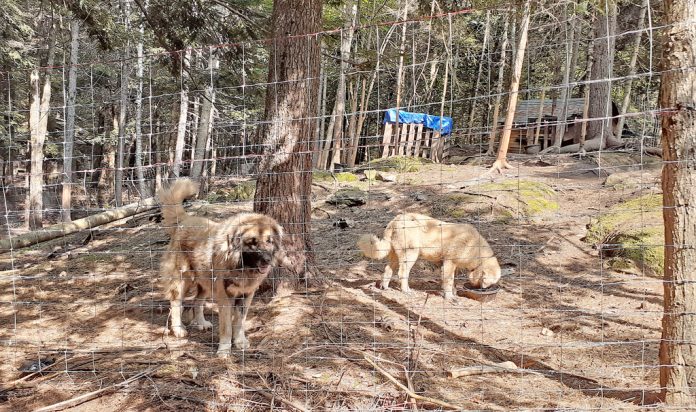
My two puppies are coming up on the 6 month mark fast. This is one of the most critical points in a livestock guardian dog’s development and the most likely place for things to go wrong.
Why? Because the novelty wanes, as the cute puppy fades into an adult dog. Also, during this transition, puppy enthusiasm starts to mature into independent thought. Like all kids, they start to think they know everything about everything. This makes obedience training, structure and rules more important than ever.
At this stage, both of my pups have been staying out overnight, tethered with the stock and spending a fair amount of time off tether during the day when I can supervise. They are both doing excellent with sheep and goats, but I’m keeping an eye on them and the free range poultry, which provide pest control in every area. I want the pups to continue to succeed.
Recently, I pulled them both back into the yard to concentrate on good citizenship skills. The night corrals up at the house are empty during the day and that makes for the perfect classroom to teach other skills. They won’t forget about the stock, and will still get experience with poultry. The birds are everywhere.
Live and learn
I use my adults to help teach some things to the younger crew. When it comes to certain behaviors, nothing gets the point across like a set of teeth. Reina spent the day, recently, with her many times great grandfather, Colter. She’s getting big enough to play rough and tumble, and my girls tend to be lenient with her. Colter, not so much. At almost 9 years old, he doesn’t care to have an overzealous bundle of puppy energy hanging off his neck ruff.
Reina is learning to be patient when there is nothing going on. Handling boredom is a learned skill, and, as we all look towards the coming winter, it’s one that will serve her well. Allanon, her half brother, is quite the opposite. He is self contained and serious. I put him in the goat corral with his father, Fitz. It was nice to see him let his hair down in a couple of good, old fashioned wrestling matches.
Having them up at the house is not just about interactions with the adults though. It exponentially increases their time with me and my belongings. This is where we tighten up on all those “nuts and bolts” I introduced to them as puppies. It’s a bit tedious, this second “broken record phase,” but I find it to be an important step in becoming a solid working adult.
Things like “don’t chew the garden hose” and “don’t touch my tools” translate well in the field, to become “don’t take the collars off the goats” — and “don’t touch my tools.” We also work on proper energy when visitors arrive at the farm. What happens when livestock are vetted or sold — and “don’t touch my tools.”
New things
Their position in the yard also puts them close to the road. They learn to handle occasional cyclists, as well as four wheelers, loud utility trailers, and the two camps visible from our place have random tenants. All these skills will be important when they work areas of the property where I can’t see them — one of which also has road footage and vehicles that slow down to look at the animals. I want to make sure the pups handle these situations properly, including what to do if a vehicle stops or a person tries to open a farm gate.
I use every opportunity I can to educate the public about the dogs and the work they do. This not only keeps everyone safe, it helps people understand why they see dogs when there aren’t people around. In recent years, this has greatly reduced calls to animal control about dogs “at large” or “without shelter.” Just because you can’t see it from the road doesn’t mean it isn’t there and whether or not they choose to use it is up to them. They are suited to all weather, unlike your pet at home.
Allanon and Reina will go back to work soon. I’ll swap them around a bit, so they get experience with all the stock. This gives me the option of using them wherever I might need them in the future, as well as observing where they like to work best. I try to put them where they are most suited. I’ll pull them randomly over the next few months to keep those new bolts tightened. Did I mention you shouldn’t touch my tools?!
By 10 months or so, they’ll be working full time and getting ready for lambing and kidding season, and a whole new set of lessons to learn.











